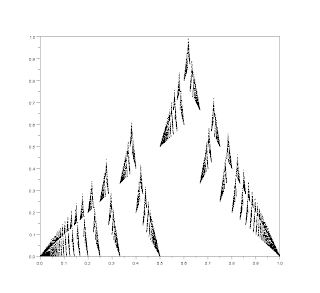First, some Scilab-powered graphic suggesting the conjectured fractal nature of the euclidean summation:
The normalized euclidean summation (m=10000 and 0<n<10000)
But science relies upon facts, so let's begin by listing some of the basic properties of the euclidean summation:
Lower boundary
[;\tau_1(n,k) = 0 \Leftrightarrow (k=0)$ or $((k\neq 0)$ and $(k|n));]
Homogeneity
[;\tau_1(p\cdot n, p\cdot k) = p \cdot \tau_1(n,k);]
Column periodicity
[;m_1\equiv m_2\pmod{n}$ $\Rightarrow$ $\tau_1(m_1, n) = \tau_1(m_2,n);]
Outer row recurrence
[;\frac{n}{2}<k<n \Rightarrow \tau_1(n,k) = n-k + \tau_1(k,n-k);]
Inner row recurrence
[;\frac{n}{2}<k<n \Rightarrow \tau_1(n,k) = n-k + \tau_1(n,n-k);]
Diagonal periodicity
[;\frac{n}{2}<k<n \; and \; 0 \le r < (n-k) \Rightarrow ;]
[;\tau_1(n + p \cdot (n-k) + r, k + p \cdot (n-k) + r) = \tau_1(n+r, k+r) ;]
Next: Boundaries for peak and positional peak

No comments:
Post a Comment